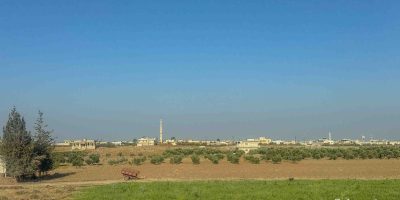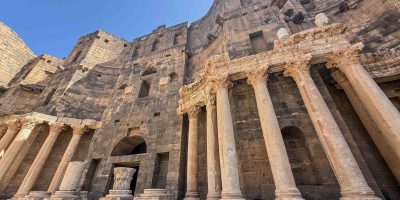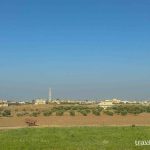After criss-crossing Old Baku for three days, I felt like venturing outside the very city. Since I had only one day left, I joined the most popular daytour from Baku: It includes 20.000 year old Gobustan rock art, Bibi Heyat Moseque, the Burning Mountain, the Mud Volcanoes, the Zarastrian Fire Temple. The last three stes ihave one thing in common – they exist because of the natural gas buried in Azerbaijan’s ground. I am glad I did the trip, if I ever return I would take my time and have these phenomens explained properly by an expert. Rushing through it it did not do them justice. None of the places are too far from Baku, some like the Fire Temple even in the outskirts of Baku.
Gobustan – Ancient Rock Art
Besides the more than 6000 rock carvings depicted on the many rock faces at Gobustan State Reserve, equally impressing are the gigantic rocks that seem to balance on top of each other. These rock served as a kind of canvas for people up to 20,000 years ago for portraying their daily life: animals, ritual dances, warriors with lances, camels, sun and stars.
The most unique attraction of the site are “singing stones”. The Gaval Dash, a natural musical stone which can only be found in Gobustan. One of the four stones sits near the entrance of the site, a lonigish 2m long rock with a smooth flat surface. The guide struck the surface with with two smaller rocks,which produced a hollow, ringing sound, resembling the sound of a tamburine.
Google says: This unique resonance is created by microscopic holes inside the rock, which are believed to result from the dry climate and the effect of natural gas in the region.
Tiny Mud Volcanoes abused by tourists
I expected something bigger than this tiny mounds sitting in this barren greyish landscape. What shocked me was that tourists were climbing on top of them, scooping out the mud, filling it in bottles, putting in all over their body. Nobody there to protect what Azerbajian wants to develop as the Baku-Gobustan-Mud Volcanoes Tourism Cluster. If those are really 300 of the planet’s estimated 700 mud volcanoes worldwide, they would deserve more respect.
I was wandering how they could touch such hot stuff. I carefully dipped my finger into the “boiling” mud to find out is was cold.
The site is quite a bit off road, the last stretch was really bumpy. I later read that this road connecting Gobustan Reserve 20km away and the 12 hectare mud volcanosite was improved recently. So it must have been real bad.
On google I later read that in April 2021, the new Mud Volcanoes Tourism Complex was opened, Luckily I did not see the quad bike track and the zip line. I regret missing out on the observation tower and therapeutic baths. I don’t want to imagine what this place will look like in a couple of years, with tourism in Azerbaijan just developing.
Bibi Heyat Mosque – overlooking the Caspian Sea
The two most unique things about this mosque are the colour and the location. The creamy coloured building sits on the edge of a cliff overlooking the Caspian Sea. Inside is the tomb of Ukeyma Khanum, a descendant of Muhammad, it attracts worshippers that pray, kiss and touch the metal work around it. A guard wipes the grid with a green clothes. I must have watched to intensively, he handed my the cloth as a present. It still site among mum many Souvenirs I took back from my travels.
The mosque was only built in 1990 after the identical model the Soviets destroyed in 1934, It is right next to the road leaving Baku south-west, about 2o minutes from Old Town Baku.
When visiting, women will be provided with a robe covering, but it is not a must, to cover your hair is enough to be allowed in.
Yanardag – Burning Mountain
What is advertised as a Burning Mountain is more of a dry grassy slope that has caught fire. Still you wonder why do these natural fires occur? Azerbaijan and especially the Absheron Peninsular is known for its rich gas reserves. The crust of the earth here is a very porous sandstone so the gas seeps to the surface naturally. Once the natural gas was being exploited massively, the number of such natural example was reduced to a couple, like the one in Yanardag
Like eveybody else I had my photo taking there, actually you have to wait quite a bit to get your slots, or you have people are carshing into the photo. A meter away from the flames it is super hot and you feel jumpy.
Ateshgah – The Ancient Zoroastrian “Fire Temple”
Like the Burning Mountain this Fire Temple in the outskirts of Baku was feed by gas for centuries. At the end of the 19th century the exploitation of gas began near the Fire Temple. This made the natural flow of gas feeding the eternal fire disappear. After millennia of continuous natural fire, the flame went out in 1969.
Brief History: Persians made Zoroastrianism the official state religion in modern-day Azerbaijan in the 6th Century BC. As Zoroastrianism spread across Asia and the Caucasus, thousands of fire temples were built to protect the religion’s sacred flames. But as Islam took hold in the 7th century AD, many of these ritual spaces started to disappear, the original temple were destroyed and the Zoroastrians fled south to the sub continent, India and Persia etc. The current temple was built around the 17th century by these pilgrims.
I have visited Zoroastrian Fire Temples in Iran and Usbekistan, so I was curious what this one was like. Well the main difference was that lots of Indians tourists were milling around.
Inside of the temple a huge open courtyard dominates, an ancient caravansary. Many of the tiny rooms leading from the court into the surrounding walls were trading places and dining, sleeping areas for passing traders and pilgrims. Some feature still show were the camels were tied to.





















Leave a Reply